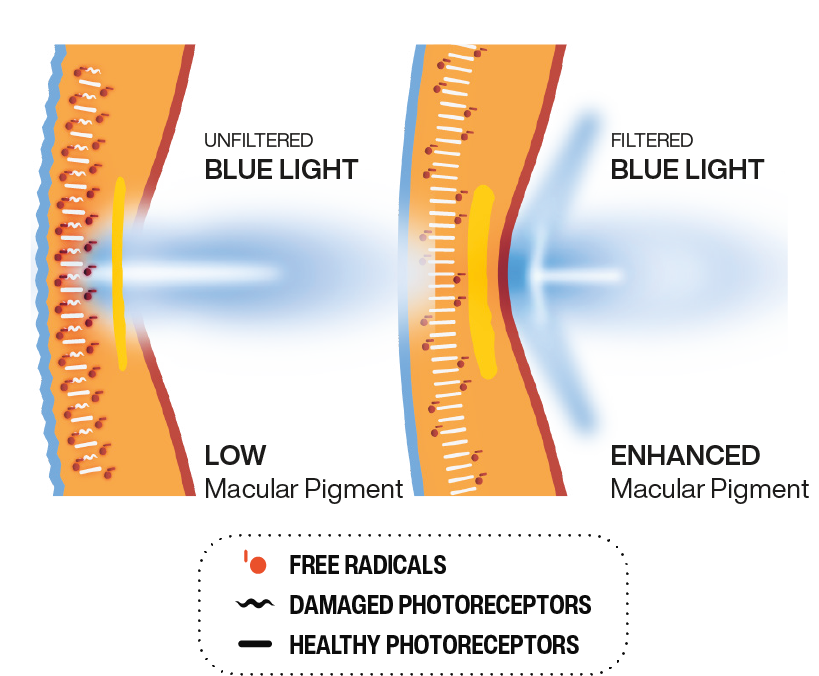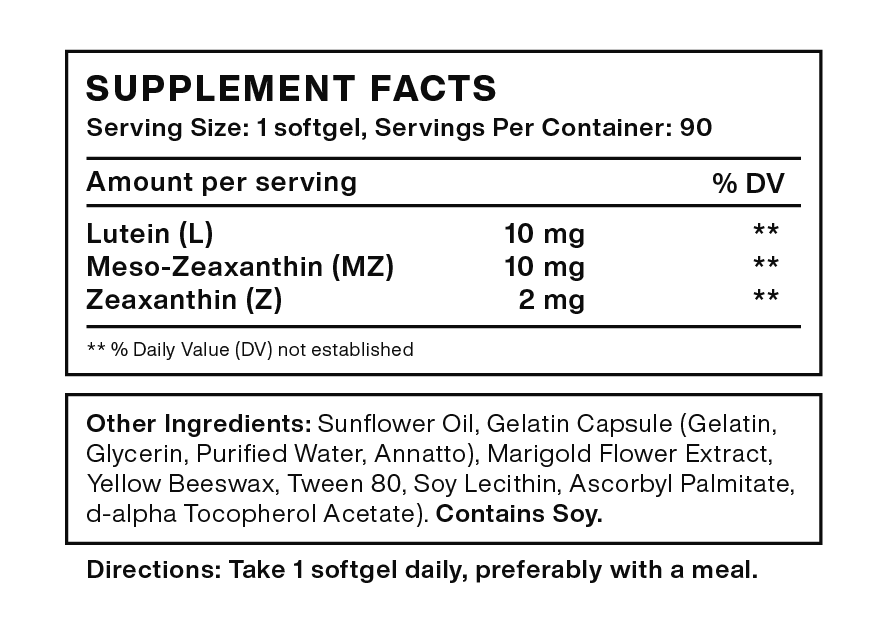There is a good chance that you or someone you know has been diagnosed with a condition called Age-Related Macular Degeneration (AMD). AMD is the leading cause of visual impairment in the industrialized world and the third leading cause of visual impairment worldwide. The macula is the part of the retina used to see something we are looking directly at. This part of the retina gives us our most detailed vision and is responsible for our ability to see colours.
You do not have to be a patient at Doig Optometry to purchase Macuhealth, we are happy to help!
What is macular degeneration?
Macular degeneration is basically a loss of structure and function of the macula, leading to loss of central vision. The exact mechanisms and causes of macular degeneration are not fully understood but appear to be multifactorial and result from an interaction of environmental, metabolic, and genetic factors.
Current research shows that some of the driving forces for the development of AMD are inflammation, oxidative stress, and a breakdown of the blood-retina barrier. Commonly accepted risk factors for developing macular degeneration include advancing age, light skin and iris colour, possibly female gender, exposure to cigarette smoke, and low levels of dietary antioxidants.
The different types of Age-Related Macuhealth (AMD)
There are two forms of AMD:
Dry or atrophic
This form of AMD is characterized by drusen and geographic retinal atrophy. Drusen are deposits of lipid, protein, inflammatory cells, and other waste products within the retina, or more specifically, between the retinal pigment epithelial cells (RPE) and Bruch’s membrane. These look like yellow-white spots within the retina.
Geographic atrophy occurs when the important RPE cells and photoreceptor cells eventually die off. This will lead to a loss of central or detailed vision.
Wet or exudative
This form of AMD is characterized by the growth of new but weak blood vessels from the choroid through Bruch’s membrane (a layer of the eye beneath the retina) into the retina. These blood vessels tend to leak and bleed and can very quickly cause devastating central vision loss.
Approximately 90% of AMD is the dry form. The dry form almost always occurs first and then, in some people, progresses to the wet form. There is no cure for AMD and no treatment for the dry form of AMD. The treatments for the wet form, which include injections of medications into the eye and laser treatments, do not cure the AMD but help to slow the progression of the new blood vessel growth.
How inflammation and oxidative stress contribute to the development of AMD
Recent research into AMD has investigated the role of nutrition in helping to slow or prevent the progression of this often visually devastating disease. As mentioned at the beginning of this article, inflammation and oxidative stress appear to play a significant role in the development of AMD, but what does this mean exactly?
To explain, a quick chemistry lesson is needed:
- Free radicals are atoms that are missing an electron or have an unpaired electron. These molecules easily bind to and damage other atoms and molecules (including molecules within the cells of our bodies) as they seek to acquire the electron they are missing or donate their unpaired electron.
- Free radicals are constantly produced in our bodies through normal metabolic processes or external sources such as radiation, cigarette smoke, pollutants, or chemicals.
- Antioxidants are molecules that inactivate free radicals by donating an electron without becoming free radicals themselves.
- Oxidative stress occurs when there are not enough antioxidants to counteract all the free radicals being produced.
- Oxidative stress can lead to activation of the immune system and chronic inflammation.
- Inflammation was designed to heal damage to our bodies and protect our bodies from foreign invaders, but chronic inflammation actually attacks our bodies and results in chronic diseases like arthritis.
Now returning to the discussion of AMD, one source of oxidative stress within our retina appears to be the blue light that impacts the retina. Blue light has higher energy than the other colours of light, and this increased energy can produce free radicals.

As it turns out, our body naturally tries to protect our macula from this high-energy blue light by building up a protective layer of yellow-orange pigment at the macula called Macular Pigment (MP.) MP is composed of three carotenoids called:
- Lutein (L)
- Zeaxanthin (Z)
- Meso-zeaxanthin (MZ)

Carotenoids are the red, yellow, and orange pigments in plants, algae, and bacteria. The more familiar vitamin A and Beta-carotene are also carotenoids. Research has shown that carotenoids can filter or absorb light, are powerful antioxidants, and have anti-inflammatory and anti-cancer properties.
The role of nutrition in slowing or preventing the progression of AMD
Humans cannot produce lutein and zeaxanthin, so we must get these carotenoids from our diet. Common foods that provide our bodies with L and Z are green, leafy vegetables like kale and spinach, yellow-orange fruit and vegetables like orange peppers, corn, squash and cantaloupe, and egg yolks.
Unfortunately, meso-zeaxanthin is not present in the food we commonly eat. It has been identified in fish skin, shrimp shells, turtle fat, and marigold petals. If our bodies do not produce MZ and we do not usually consume it in our diet, how does it end up in our macula? As it turns out, a chemical called RPE65 can convert L to MZ.
That is the good news, but the bad news is that the typical North American diet does not provide enough L, Z and MZ to produce an adequate macular pigment layer. This lack of macular carotenoids in our diet has prompted researchers to conduct many studies to determine if supplementation with various vitamins and carotenoids can increase MP, prevent or slow the progression of AMD, and improve visual function.
The most well-known of these studies are the AREDS and AREDS2 studies:
- The AREDS study demonstrated that supplementation with zinc, copper, vitamin C, vitamin E, and beta-carotene resulted in a 25% reduction in progression from non-advanced to advanced AMD.
- The AREDS2 study demonstrated a further 9% reduction in progression when lutein and zeaxanthin were added to the supplementation.
Further studies have demonstrated that supplementation with L, Z and MZ increases the concentration of these carotenoids in our blood, increases the amount of macular pigment, and can improve visual function in areas such as contrast sensitivity, glare disability, and bright light recovery. Studies have also determined that supplementation of MZ, L and Z in a ratio of 10:10:2 mg is ideal.
Promoting Macuhealth at Doig Optometry
After reviewing many of these studies, Dr. Doig and Dr. Chorel feel confident in recommending that most patients with non-advanced AMD and patients with a low dietary intake of carotenoids would benefit from taking a quality supplement designed to enhance MP.
Dr. Doig and Dr. Chorel feel that Macuhealth is one of the best of these supplements. This product contains the antioxidant vitamins recommended by the AREDS 2 study with the addition of MZ in the recommended ratio of MZ: 10 mg, L: 10 mg and Z: 2 mg. It also has a safer level of zinc (25 mg compared to 80 mg.)
Finally, it has also been tested to demonstrate that the contents of the capsules meet the claims on the package. Macular carotenoids can degrade over time when in a supplement form. Studies have shown that the type of capsule and how the carotenoids are packaged will significantly affect the rate at which these molecules degrade because antioxidant vitamins are degraded by oxygen.
Specifically, macular carotenoids in an oil-filled soft gel capsule are relatively stable over time, while carotenoids in a powder form will degrade over time. In fact, the carotenoid content in some powder-filled capsules has been shown to degrade to 0% before the expiry date on the package is reached.
Macuhealth is an oil-filled soft gel capsule produced in an environment designed to reduce the degradation of the carotenoids within the capsule so the consumer can feel confident that the carotenoid content of the capsule is at the level claimed on the package.
If you have any questions about Macuhealth or your macular health, please feel free to call Doig Optometry and book an appointment with either Dr. Doig or Dr. Chorel.
